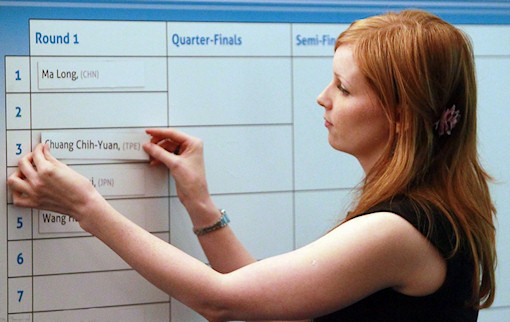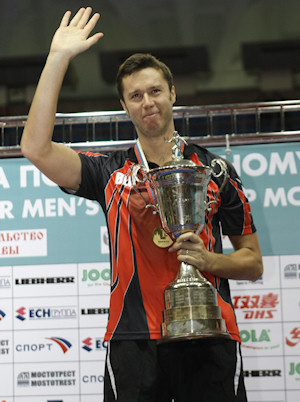You Are Here: Home » Table Tennis Clubs » Competition and Tournament Systems of Play
Competition and Tournament Systems of Play
What types of competition and tournament systems of play are there?
Which is best? Find out here...
By Martin Hughes
Owner and Editor
Many table tennis clubs organise competitions or tournaments for their members, but what playing system should you use?
Which system of play is best?
Well, it depends on a number of factors including whether you want to hold an individual tournament or competition or a team tournament or competition.
 by courtesy of the ITTF
by courtesy of the ITTF
So let's take a look at some different competition and tournament systems of play and look at their advantages and disadvantages.
TABLE TENNIS EXPERT
REVEALS HIS SECRETS
Click Here For Details

Click here for a large selection of
table tennis equipment at Megaspin *

Click here for a large selection of
table tennis equipment at Bribar *
^ Top of page ^
So what are the...
Basic systems for individual events
There are two basic competition and tournament systems of play that you can use for individual events.
They are the simple knock-out system and the group / round-robin system.
So let's take a quick look at each of these and discover the advantages and disdavantages of each one.
1. Simple Knock-out
 by courtesy of the ITTF
by courtesy of the ITTF
This system is used for all the major tournaments including the Olympic Games, World Championships, World Cup and ITTF World Tour.
How it works:
- Players are allocated or drawn in pairs
- Winners continue to play in successive rounds until only one player remains unbeaten
- Losers are knocked-out
Advantages:
- Simple to understand
- Needs the fewest number of matches and therefore can be completed in the shortest time
Disadvantages:
- Half of the players are eliminated in the first round
- Does not produce a final ranking order
TABLE TENNIS EXPERT
REVEALS HIS SECRETS
Click Here For Details

Click here for a large selection of
table tennis equipment at Megaspin *

Click here for a large selection of
table tennis equipment at Bribar *
^ Top of page ^
2. Group / Round-robin
How it works:
- Players are allocated or drawn into groups containing 3, 4 or 5 players
- Each player plays every other player in their group
- The results of matches
determine the final ranking order for the group
then... - A pre-determined number of players (usually the top one or two) progress from each group into a knock-out competition, whilst the others are eliminated
- Winners continue to play in successive rounds until only one player remains unbeaten
- Losers are knocked-out
Advantages:
- Guarantees that all players will have more than one match
- Provides a final ranking order for each group
Disadvantages:
- No 'final' within each group
- No certainty that the last group match played will decide the group winner
- The number of matches rises rapidly as the size of the group increases. Therefore you usually need to limit the number of players in each group to a maximum of 5.
- Takes longer to play all matches
^ Top of page ^
There are also two...
Variations to the Simple Knock-out system
In order to provide losing players with more matches when using the simple knock-out system, there are two variations which can be used.
Variation 1 - Double Knock-out
How it works:
- Losers are entered into another knock-out competition (sometimes called a consolation or plate competition) instead of being eliminated
- This secondary knock-out competition is then played in the same way as the original knock-out competition
Advantages:
- Gives first round losers a second chance
- This system can also be further extended to allow for two or more losses
Disadvantages:
- Doubles the number of matches to be played, so takes longer
- Does not determine ranking
And...
Variation 2 - Progressive Knock-out
How it works:
- Winners continue to play other winners until only one player remains unbeaten
- Losers continue to play other losers
- Players losing in the first round cannot finish in the top half of the final order
- Players losing in the first and second rounds can only compete for places in the lowest quarter
Advantages:
- Provides a full ranking order
- Provides a decisive final
- Gives all participants the same number of matches
Disadvantages:
- Takes longer to play all matches
^ Top of page ^
Let's now take a look at the different systems for...
Team competitions
If you're playing team competitions there are many different systems you can choose from. But let's take a look at some popular systems of play for team competitions where there are 2-5 players per team.
Team Match Procedure
Before the match starts, the right to choose whether your team will be A,B,C or X,Y,Z should be decided by lot (for example, by tossing a coin).
The captains will then assign a letter to each player.
The pairs for a doubles match need not be decided until the end of the immediately preceding singles match.
For any of the following systems of play there is the option for the match to finish when one team has an unbeatable lead.
So for example, when playing best of 5 matches, the match may stop when a team has won 3 matches. Or when playing best of 9 matches, the match may stop when a team has won 5 matches. Alternatively, you can play all the matches.
^ Top of page ^
Team Match Systems of Play
System 1. 5 Singles
This system is used for the World Championships Team Events.
 by courtesy of the ITTF
by courtesy of the ITTF
How it works:
- A team consists of 3 players
- Best of 5 Matches (5 singles)
- The order of play is A v X, B v Y, C v Z, A v Y, B v X
Advantages:
- All of the players must have played at least one match for their team to reach a winning score
- Needs the fewest number of matches and therefore can be completed in the shortest time
Disadvantages:
- One player from each team only gets one match
^ Top of page ^
System 2. 4 Singles and 1 Doubles
How it works:
- A team may consist of 2, 3 or 4 players
- Best of 5 Matches (4 singles and 1 doubles)
- The order of play is A v X, B v Y, doubles, A v Y, B v X
Advantages:
- It's possible to form a team with only 2 players
- Up to 4 players can all play in one team
- Either or both of the doubles players may be different from the singles players
- It's possible to vary the last two singles to allow players 3 and 4 to play, so that all players will play at least 1 singles each
Disadvantages:
- One strong player can dominate a match by winning two singles and playing a decisive part in the doubles
^ Top of page ^
System 3. 4 Singles and 1 Doubles
How it works:
- A team consists of 3 players but each player can only play in a maximum of 2 individual matches
- Best of 5 Matches (4 singles and 1 doubles)
- The order of play is A v X, B v Y, doubles C&A or B v Z&X or Y, B or A v Z, C v Y or X
Advantages:
- All of the players must have played at least once for their team to reach a winning score
- Less chance of one strong player dominating a match
- All players have 2 matches
Disadvantages:
- It's not possible to form a team with only 2 players
^ Top of page ^
System 4. 6 Singles and 1 Doubles
How it works:
- A team may consist of 3, 4 or 5 players.
- Best of 7 Matches (6 singles and 1 doubles)
- The order of play shall be A v Y, B v X, C v Z, doubles, A v X, C v Y, B v Z
Advantages:
- 3 players must have played at least one individual match for their team to reach a winning score
- It's possible to vary the last three singles to allow players 4 and 5 to play, so that all players will play at least 1 singles each
Disadvantages:
- The 4th and/or 5th player might only play in the doubles
- May take a long time to complete all 7 matches
^ Top of page ^
System 5. 9 Singles
How it works:
- A team consists of 3 players.
- Best of 9 Matches (9 singles)
- The order of play shall be A v X, B v Y, C v Z, B v X, A v Z, C v Y, B v Z, C v X, A v Y
Advantages:
- Less chance of one strong player dominating a match
Disadvantages:
- Unpredictable length of time required. The match may be completed quickly if the score is 5-0, or last more than 4 hours if all 9 matches are played
Remember, there are also many other possible variations for playing team events. You just have to decide which system of play works best for you.
^ Top of page ^
| MORE PAGES ABOUT TABLE TENNIS CLUBS |
|---|
For more information about table tennis clubs, take a look at these pages too...
Running a table tennis club
Finding a table tennis clubHow to find a table tennis club in... |
Click here for a large selection of
table tennis equipment at Megaspin *

Click here for a large selection of
table tennis equipment at Bribar *
^ Top of page ^
You Are Here: Home » Table Tennis Clubs » Competition and Tournament Systems of Play
